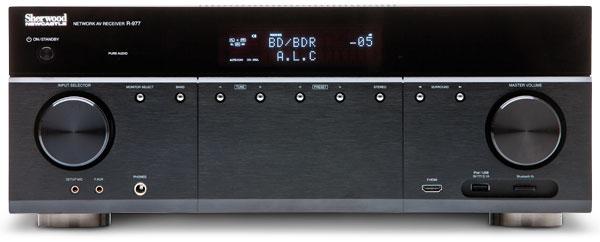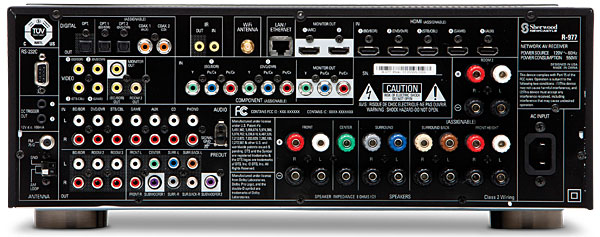Sherwood R-977 A/V Receiver

Sherwood can fairly lay claim to a slice of audio history. Born in Chicago in 1953, it was one of the great American brands of home audio’s infancy. Its vintage tube amps still sell on eBay as affordable alternatives to more sought-after brands like McIntosh and Marantz; some folks make a hobby of refurbishing them. Its early solid-state stereo receivers also have a modest following. A Korean company now known as Inkel took over the brand in 1980, and since then Sherwood has maintained a low-key but constant presence as a maker of both surround and stereo receivers—some sold under its own name, others manufactured for other brands. Today, Sherwood products are designed in the U.S., made in China, and sold in Walmart, Sears, and Home Depot, if you absolutely must buy a receiver in one of those places.
Under its higher-end Sherwood Newcastle brand, the company has sold high-aspiring products such as the R-972 ($1,800), the first—and unfortunately, only—receiver to use innovative Trinnov room correction. It is still listed on the Sherwood America Website. The R-977 reviewed here aims its aspirations in another direction, offering both built-in Wi-Fi and Ethernet connectivity to access music from the Internet or a PC. The USB input is compatible with iOS phones, tablets, and music players as well as external drives. And for users of mobile devices, the wireless angle is covered with the inclusion of the BT-R7 Bluetooth dongle. The price for all this network audio versatility is an even thousand bucks.
Two-Tone
The R-977’s front panel is plastic at top, metal at bottom, and soothingly simple to look at by AVR standards. Input selection is covered by a knob, reducing buttons to the bare minimum needed for listening-mode selection and tuning. There are a couple of unusual courtesies to the user: If you use more than one video display, you might like having a monitor-select button on both the front panel and the remote control. The front panel also sports an analog minijack for any mobile devices not covered by Bluetooth or USB.
The remote’s thin rectangular buttons have a pleasing rubbery feel, though Sherwood has succeeded all too well at camouflaging the volume up/down keys in the fifth and sixth rows from the top. The graphic user interface is near-monochrome white on gray/black with pleasant amber highlighting and the occasional use of diagrams for such things as speaker layout.

Power is rated at 145 watts times seven channels—but that’s with a 1-kilohertz test tone into 6 ohms and only one channel driven. Rated stereo power from 20 hertz to 20 kHz into 8 ohms is 125 watts. As always, see our measurements for an independent perspective. In addition to the basic five speaker outputs, there are separate sets of binding posts for back surround, front height, and second zone, so you can switch among them without moving speaker cables around behind the receiver and getting red in the face.
Connectivity is pretty up to date with a total of three high-def-capable outputs, two HDMI, and one component video. The six HDMI inputs include one on the front panel, where you’ll also find the USB jack that accepts an iPhone, iPad, or iPod. The USB jack is conversant with the MP3, WAV, WMA, and AAC file formats. A moving-magnet phono input nestles among the RCA stereo line inputs. While there is no multichannel analog input for an antique disc player, there is a set of 7.1-channel analog outs (plus a second subwoofer output) to allow the receiver to serve as a surround pre/pro with a more powerful multichannel amp.
The review sample originally did not come with a setup microphone, so I performed both manual and (later) automatic setup. During manual setup, the test tone for the LFE channel was abnormally high—I cut it to the lowest setting allowed by the receiver (–15 decibels) and rotated the sub’s volume dial well below my normal one-third setting. Sherwood’s proprietary SNAP (Sherwood Newcastle Automatic Parametric) setup and room correction scheme later concurred with the –15 dB adjustment.
Set Me Up
Auto setup was an adventure: The system would emit test tones for the front left, center, right, and surround right channels; then it would bog down, omit the surround left and sub channels, and complain of ambient noise conditions. With the window already closed, I tried twice, silenced the work PC, tried twice more, left the room for the next few tries to eliminate the sound of my own breathing, and finally found the problem. The room was quiet enough, but the subwoofer was attached to the Sub 2 preamp output. Apparently SNAP checks the Sub 1 output first. I call this a design quirk, though the designer might call it a reviewer quirk. Setup completed, I checked speaker distances. They were in the ballpark within half a foot, which seemed to be the smallest increment of adjustment. All speakers were set full range, which is not a bad assessment of my chunky monitor speakers, though the 40-Hz crossover chosen by many other auto setups is closer to the mark. I reset
them all to 80 Hz, per normal procedure. (I rarely explain
why I do this: It’s to reduce bass demands on the receiver and main speakers to give the system
a better shot at reproducing movie-worthy dynamics. 80 Hz is the sub crossover recommended by THX.)





























































